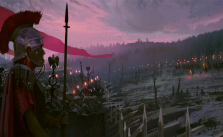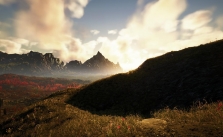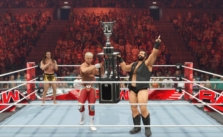Old World – Ultimate Beginner’s Guide: Essential Tips and Tricks to Get You Started
In this beginner’s guide, we will share Old World tips and tricks. Here’s a collection of random tips and tricks that we hope you’ll find useful.
- At game start, the exact improvements you’ll be able to build will vary depending on what Nation you select, because each Nation has different starting techs, but regardless of which Nation you’re playing, your starting worker (and yes, you get one, right out the gate) will have at least a couple of things he can do.
Naturally, this invites players to experiment with different Nations to find the one(s) that are best suited to their playing styles, but again, a Nation is more than just a collection of top-level bonuses. Remember, each Nation is constituted of four different noble families, and you only get to pick three during any one game, so even within your favorite Nation, there’s lots of room for experimentation, because different combinations of Noble Families will yield a Nation with very different capabilities and a totally different feel.
- As you play more games of Old World, you’ll start noticing a trend. Pretty much any time Rome is in the game, they’re at, or near the top of the power chart. That’s because Rome is one of the strongest, if not the absolute strongest Nation in the game. Playing as Rome is almost like playing at a difficulty level lower than the one you selected.
This isn’t just a combat-oriented Nation, everything about Rome is geared toward making killing your rivals easier. You have access to the Champions family, which gives you access to units with Steadfast for a +25% bonus against barbarians. All your units get an extra point of movement and level up 50% faster than anybody else’s units, gaining more promotions, more quickly. All your cities generate +2 additional Training Points each turn.
- The tech “Aristocracy” is so important to your early game success because it allows you to appoint an Ambassador. If you get into an early game war without an Ambassador, you have no way to ask for peace because only Ambassadors can do so, which means you’re stuck in the war until the nation you’re fighting decides to let you out, which isn’t good.
- If your leader is a Commander, then idle military units get +10 XP per year (this stacks with the XP you get from barracks/ranges), and you’ll be able to hurry the training of units in all your cities with Orders. Also, Infantry units see a +10% defensive bonus.
- Choosing the Judge archetype for a character immediately grants that character +2 Charisma and +2 Discipline. If you have a Judge Leader, you may “Hold Court” which is a way of converting Training Points to Civics, and the cost of switching laws is decreased by 50%. Judge leaders may also upgrade existing improvements (so if you have a garrison, instead of building a separate stronghold, you can just upgrade your garrison TO a stronghold).
- You can always see how many orders you have currently, and how many you’ll have next turn by looking just to the right of your character portrait (lower left-hand corner of the screen when you’re looking at the game map).
- If you’re going to war with a rival nation, and he has a staunch ally, and you’re worried about having to fight them both, start a whisper campaign against the nation you’re planning to fight to drive a wedge between that nation and his staunch ally. They won’t be allies for long, and while you’re doing that, you can be sending your Ambassador on trade missions with your rival’s ally, eventually wooing that nation into your circle. Once you’re friends and he’s seething at his former ally, it’s usually a simple matter to bribe your new friend to go to war with his former ally, and you can follow suit a few turns later, utterly devastating your target.
- If you spent 100 Training, you may order a unit to execute a “Forced March.” Doing so will allow you to move that unit farther than it would normally be able to, but each point of movement beyond its normal limit takes two orders to execute.
- There are two “layers” to the Old World economy. The primary layer is resource-based. When you send a worker out to build a mine, farm, quarry, camp, etc., doing so will generate either food, iron, stone, wood, or money. In addition to the fact that all of the tile improvements your workers build cost some number of the above resources, most buildings and units also have a per turn upkeep that will require you to keep growing these resource totals throughout the game, so you can support more advanced buildings, construct wonders, support more units, and the like. It also bears mentioning here that Population Food/Iron/Wood/Stone costs are now scaled with city culture increases.
On top of that, the economy also runs on a number of secondary resources. These include:
• Civics (used for building city projects, conducting diplomacy, and the like)
• Training Points (used by cities for training new troops, or used by you to upgrade existing troops, conduct special field maneuvers if you have certain types of military leaders, handle promotions, etc.)
• And Science (researching new techs)
- If you’re perplexed about how you actually build your Nation’s unique units, you’re not alone. Here’s how you do it:
• To build the lesser of your UUs, you need a city with at least Developing Culture and you need to build a Stronghold in that city (which first requires building a Garrison).
• The availability of these improvements are dependent on the number of Laws you have enacted. Two laws are required to build a Garrison, and four are required to build a Stronghold. To build the stronger of your UUs, you need a city with at least Strong Culture and you need to build a Citadel, which requires that you have at least six laws enacted.
• Also note that some UUs require horses or elephants to build. If your chosen Nation has a UU with that requirement, then you’ll either need that resource inside the borders of the city you want to build the UU in, or you’ll need access to the Riders family (Rider family cities can build UUs even if you don’t have access to the resource in question).
- Most buildings and units (including non-combat units like workers) require some number of resources per turn as an upkeep cost. Workers, for example, consume two food, while a Granary consumes 1 wood, every turn, so just because you have a surplus now doesn’t mean you always will. You’ll basically want to keep growing your economy for the entire game to ensure good surpluses everywhere. Hovering your mouse pointer over any of the resource values will display a popup that will give you additional information about how your resources are being generated and how they’re being spent or consumed, which is very handy if you’re just looking for a top-level view of aggregate production and consumption.
- When a city is training a military unit, it’s using 100% of its Training Points to do that, so for however many turns it takes to train that military unit, the city doing so is adding 0 to your national military training stockpile. Similarly, if you set a city to building walls, or training a specialist, or completing some other city-related project, then for the duration of that project, the city in question is adding 0 Civics to our national stockpile. What that means, in a nutshell, is that you seldom want to set all your cities to training troops or building specialists. If you do, then you’ll almost certainly start running a Civics/Training Point deficit, and you won’t be able to do things like send your diplomat on trade missions to keep rivals happy (which takes Civics), or upgrade your existing army (which takes training points). Balance is the order of the day here.
It’s also worth mentioning that your national stockpile of both Civics and training points is capped at 2000. If you have 2000 and you’re generating a surplus of Civics or training points, then the excess (anything over 2k) will be converted into orders (in the case of training points) or science (in the case of Civics) at a 100:1 rate.
- Culture is an investment that takes time to pay off. The earlier you make that investment, the faster you start seeing returns. Generally speaking, I like to put at least one triad of quarries in every city. That way, every city can train 3 stonecutters. Stonecutters generate Civics. By training specialists that generate Civics first, then building a forum, you can speed the progress of every other specialist that city produces for the rest of the game.
Note too that specialist costs scale, so they will take progressively longer to train as the game grinds on. The more ways you can find to bulk up a city’s Civics count, the more you can counteract this trend.
- Religion is a surprisingly important and powerful aspect of the game that will help you keep your families happy, and perhaps a rival AI Nation or two, if you can get them to convert to the religion you found and adopt for yourself.
There are two types of religion in the game. Pagan Religions, which every nation can found, and World Religions. Pagan religions are available early in the game. They don’t spread on their own, and you don’t get Disciples like you do when you found a World Religion. You spread them by building Shrines (available at Divination, so very early on), and every Shrine you build grants a +2 relationship bonus with the head of your Pagan religion.
- There are a total of sixteen wonders in the game, but in any given game, only 13 will be present (selected randomly). Wonders are powerful, but time and resource intensive projects that offer compelling advantages to the Nations that build them (or capture them later). The interesting thing here is that since not all wonders appear in every game, it’s impossible to build a reliable strategy around any particular wonder. They can serve to augment a strategy, but you’ll have to make peace with the idea that you can’t guarantee you’ll be able to build the Pyramids (or whatever your favorite wonder is), every single game.
Also, note that wonders are tied to cultural levels in addition to specific techs, so if you’ve got your eye on a mid to late game wonder, cultural improvements really matter because if you can be the first Nation to achieve a given culture level, and you’ve got the appropriate tech…
- While diplomacy with other Nations is pretty straightforward, internal diplomacy can be a highly complex metagame in its own right. Not all characters are created equally. Heads of families and heads of religions are much more important than most other family members, so focus your diplomatic (Influence) efforts there, and don’t forget to pay attention to your “Small Council” members (Spouse, Ambassador, Chancellor, Spymaster) because if you can get them to pleased, you’ll reap additional benefits based on their stats.
- In Old World, a unit is considered flanked if you have a unit on opposite sides of it (so for example, if you’re attacking a unit and you’ve got your own units on tiles due east and due west of that unit, it is considered flanked. You get an attack bonus when flanking, if you are using a general with the Commander archetype who is also your current ruler.
- Some units (mostly cavalry) have the “rout” ability. This enables them to attack again (orders permitting) if their first attack kills the unit they hit. That’s huge. If you pair cavalry with units that can damage multiple opponents (onagers, Akkadians, Cimmerians, axemen, etc.), then you can use those units to weaken a group of attackers and send a unit with “Rout” in to finish the whole batch off. Absolutely deadly.
- Here’s a tip/trick I only recently discovered: When you anchor your ship, you don’t have to include the coastline IF your borders extend into the water.
My habit had always been to make sure my “anchorage zone” touched the shore but this isn’t necessary if your borders extend into the water on the coast. As long as your anchorage zone touches your coastal borders, you’re good, which means that you can often increase the width of your anchorage zone by 1 additional tile, which could mean the difference between needing two ships or just one.
- Fortification is one of the best and easiest ways to get a defensive bonus for infantry units. It costs an order to initiate, but every turn your infantry unit does not move, he gets a +5% defensive bonus (to a max of 25%). Note that you can still attack, you just can’t do anything that would cause you to leave the tile or you lose the fortification status and any bonus you may have accumulated.
















